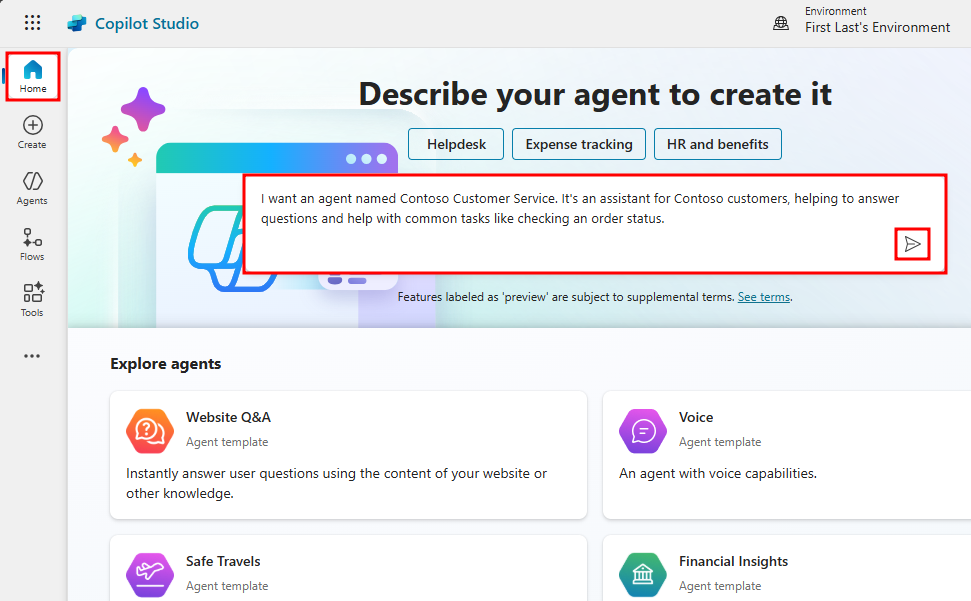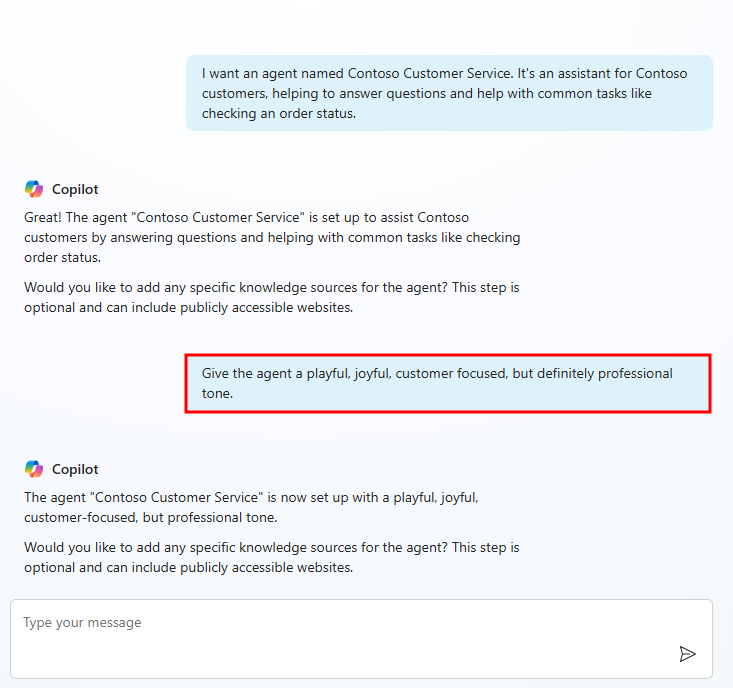Get started with Generative AI - agent creation
You'll likely be excited to get started with building an agent using Microsoft Copilot Studio. This first lab, Planning your first agent, has been written to help provide guidance on how you and your organization can get started thinking about what problems your agent can solve and where it can be deployed. We understand that you want to begin right away, however in this section you'll learn why it's important to first see what can be achieved with Generative AI in Copilot Studio as it might determine what topics you choose to manually author in the studio's authoring canvas.
Section 1: Sign in to create an agent
Your first task is to sign in so that you can create your agent.
Go to https://copilotstudio.microsoft.com/ and type in your email that you'll use to build the agent. Sign in with your work, school, or developer account if you aren't working with an instructor.
Note
Your account might already have been set up. If screens similar to the following images don't show, you can skip to step 7.
Select Next.
Select Get started.
Select Get started under Confirmation details.
Select your country/region and then select Start free trial.
Important
Skip to here if your account was already set up.
You should be redirected to
copilotstudio.microsoft.com. If not, go to the maker environment URL for Microsoft Copilot Studio:copilotstudio.microsoft.com. An Environment selector box is located in the upper-right corner. An environment is where your organization stores, manages, and shares the agent, business data, apps, and Microsoft Power Automate flows. You can select the Environment selector button to display the agents within that environment.If you're working with an instructor, confirm now with your instructor the environment to use, if you didn't already do so.
If you aren't working with an instructor, and you're using your own environment, for the purposes of this course, you can use the default environment. Alternatively, if your tenant allows, an admin can create your own environment to use in
admin.powerplatform.com.For more information, see Manage default environment.
Section 2: Create an agent
From the Microsoft Copilot Studio Home page, describe your agent to create it. Put in a description like the following:
I want an agent named Contoso Customer Service. It's an assistant for Contoso customers, helping to answer questions and help with common tasks like checking an order status.You'll get redirected to an optional conversational experience to further customize your agent. You can provide further details to the description and you can also provide a tone of voice.
Start by adding a tone of voice to the agent. Type the following prompt into the chat box:
Give the agent a playful, joyful, customer focused, but definitely professional tone.Next, you'll be asked to provide sources for important information. We'll be using publicly accessible websites. Type and enter the following:
Information should come from https://learn.microsoft.com/en-us/microsoft-copilot-studio/ and from https://www.microsoft.com/en-us/microsoft-copilot/You'll also be asked for topics or tasks the agent shouldn’t help with or talk about. Type and enter the following:
We don't want to discuss other brands like Fabrikam. Never provide product comparisons with competitor technologies.In the right side of the window, you'll see a summary pane that displays all the parameters and information you provided to the agent.
Next, above the summary pane, select the ellipses (...) and select Edit advanced settings.
In the Advanced Settings window, change the Schema Name from the default agent, to
ContosoCustomerService.Finally, select Create in the top-right corner to finalize your adjustments.
Note
After you've selected Create, the process of creating the first agent within a new environment can take up to 15 minutes. Subsequent agents are created much faster.
Note
After creating the agent, a pop-up window may appear showing new features in Copilot Studio. To continue past this, click Next three times and Done at the end.
After a few minutes, you'll be redirected to your agent's Overview page.
After you create your agent, it appears in the list under the Agents menu in the left navigation bar.
Tip
If you've created an agent in this environment before, to create another, select the Agents menu item on the navigation bar and then select New Agent.
Within the Agents menu, you can select from the agents that are available to you. Selecting the ellipses next to an agent brings up a drop-down with controls like open the agent, export the agent, and delete. You can also select the name of the agent, which opens it.
Section 3: Take a quick tour of the user interface
Microsoft Copilot Studio makes it easier for you to build basic to advanced agents. The following section reviews the main pages of the maker experience for Microsoft Copilot Studio.
Because the Agents area was explained in the preceding section, the ensuing section will cover the main options that are available after you select an agent.
Overview - Displays your home page, including a summary of the agent's Details, Knowledge, Topics, Actions, and Publish status.
Knowledge - Where you can provide a knowledge base as grounding data for your agent that enables it to pull information from specific data you provide.
Topics - Provides a list of all the Topics available to your agent. These Topics are conversation paths you develop to determine how your agent responds to specific scenarios.
Tools - Where you can add Tools that your agent can use. Tools are similar to Power Automate actions, which give your agent access to real-world tools like updating a Dataverse table or sending an email.
Analytics - Provides view metrics to monitor how well your agent is operating. The various Analytics sections include: Overview, Effectiveness, Usage, and Satisfaction.
Channels - Allows you to publish and connect your agent with various websites, web-services, and integrations into your own website.
Section 4: Take a tour of Analytics
Microsoft Copilot Studio makes it easy to analyze the results of your agent's sessions with users. To view the analytics of your selected agent, select Analytics from the top navigation bar of your agent's home page.
When you first explore the Analytics section, you'll be taken to a summary page. This page displays key performance indicators (KPIs) from your agent's session logs. These KPIs are split into different sections that provide a snapshot of indicator domains. The different sections include:
Overview - Key data and trends for the agent. The KPIs in this section include:
- Total sessions - A session starts when a conversation starts, and each time the user changes the subject. The total includes engaged and unengaged sessions.
- Engagement - The percentage of sessions where the user replied to your agent at least once. High engagement is good news.
- Satisfaction score - The satisfaction score is based on user survey responses.
- Billed messages - The number of messages during the selected period that you'll be billed for. It takes a while for this data to update, so this number might not reflect all billed messages.
Effectiveness - Effectiveness of the agent in solving user issues. This section includes an outcomes and engagement chart that displays how many users chatted with your agent, and whether it was able to answer their questions. The outcomes and engagement chart displays the following tracked outcomes:
- Resolved - A session ends and is considered resolved when the End of Conversation topic is triggered and the user confirms that the interaction was a success or lets the session time out.
- Escalated - A session ends and is considered escalated when the Escalate topic is triggered or a Transfer to agent node is run (the current analytics session ends, whether the conversation transfers to a live agent or not).
- Abandoned - A session ends and is considered abandoned when an engaged session times out after 36 minutes and didn't reach a resolved or escalated state.
- Unengaged - A session starts when a user interacts with your agent or the agent sends a proactive message to the user. The session begins in an unengaged state.
Note
The following screenshots display the analytics data from a sample agent. When you first create an agent, there's no session history to pull data from. To review analytics for your agent, you'll need to first publish the agent to a channel, and have end-users interact with it.
Usage - Agent usage and answer quality. This section includes the following KPIs:
- Answered questions - Total number of questions that were answered by your agent.
- Unanswered questions - Total number of questions that weren't answered by your agent.
- Answer rate and quality - Your agent's performance in answering user questions. This includes the percentage of questions answered and the quality of AI-generated answers. The answer quality chart is split between two answer quality indicators: Good and Poor.
- Good - A good answer quality indicates the answer is complete, relevant, and based on the agent's knowledge sources.
- Poor - A poor answer quality indicates the answer was incomplete, irrelevant, or an available knowledge source wasn't used to answer the user's query.
Satisfaction - Customer satisfaction with the agent. This section includes two tracked subsections:
- Reactions - Users can react to agent messages. The tally of positive and negative reactions appears here.
- Survey results - The satisfaction score is based on user surveys.
Section 5: Take a tour of Settings
The settings panel, which you can navigate to by selecting the Settings button in the top-right of Copilot Studio, contains all the settings available to an agent. Settings allowing you to quickly make security changes, add skills, or set the agent's orchestration mode.
Generative AI – Where you can configure the orchestration mode of your agent and advanced Generative AI features like deep reasoning, multi-agent orchestration, response models, moderation settings, knowledge grounding, file processing, and tenant graph grounding.
Agent details – Where you can update the agent display name, icon, and view its attached solution.
Security – Where you can share your agent with other users (to coauthor it) or with security groups (to use it). This is also where you configure end-user authentication settings (the type of authentication and whether it's enforced or not), and web channel security that allows you to further secure the Direct Line channel that is used for any web or custom application deployment.
Entities – Copilot Studio comes with many prebuilt entities to help identify key information in a user utterance (e.g. a city, date, number, etc.). This menu is also where you can define your own closed-list entities or regular expression entities.
Skills – Where you can extend your agent using skills. If you have already built and deployed bots in your organization (using pro-code tools, including the Microsoft 365 Agents SDK) for specific scenarios, you can convert such a bot to a skill and embed the skill within a Microsoft Copilot Studio agent.
Languages – Where you can configure additional languages your agent can be used in and localized into.
Language understanding – Where you can configure custom language models developed and trained on Azure AI Language, in Azure Conversational Language Understanding (CLU). When configured, this effectively replaces the out-of-the-box natural language understanding model (NLU) for intent detection, and can also replace entity detection and extraction.








